Summary
This page compiles estimates of numbers and biomass of invertebrates, bacteria, and other soil organisms per unit of land area from various sources.
Contents
Comparisons among organisms
Smil (2013)
Smil (2013) includes the following table (p. 21), where most of the sources for these numbers are explained on pp. 20-21:
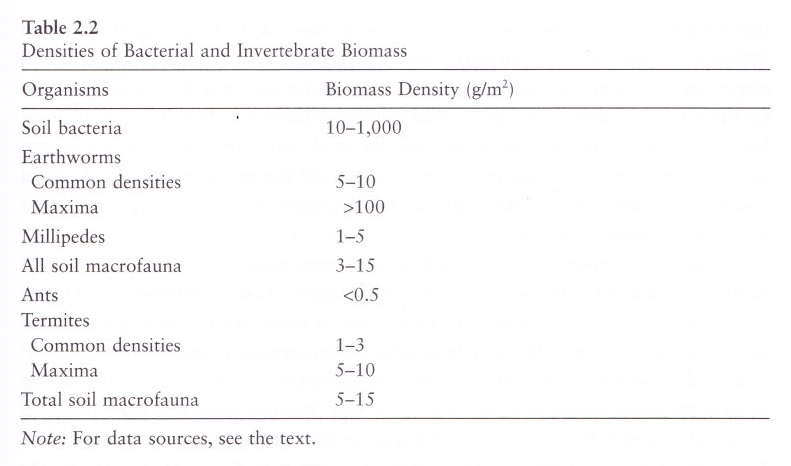
I don't know what the difference is between "All soil macrofauna" and "Total soil macrofauna".
Brady (1974)
Brady (1974) (p. 116) gives the following table. I think "Number per gram" means "Number per gram of soil", not "Number of individuals per gram of biomass".a
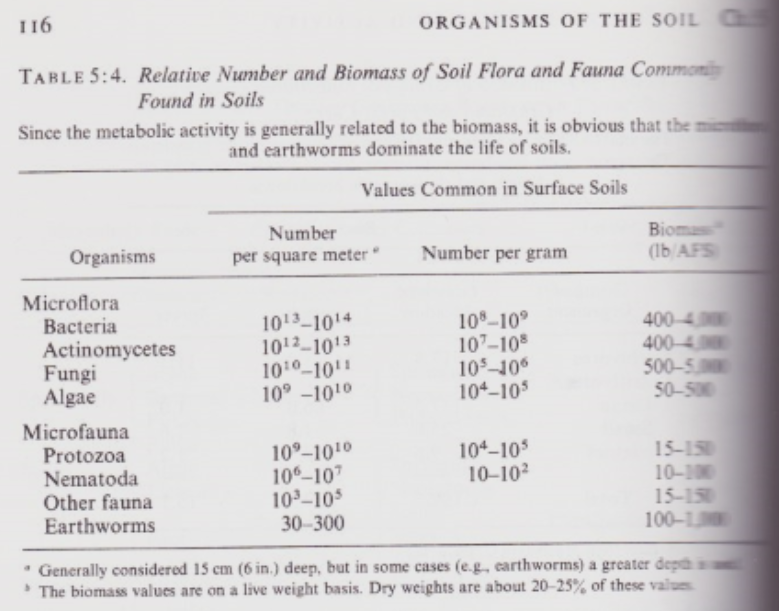
Pearse (1946) notes (p. 142) regarding soil organisms: "Waksman (1932) says protozoans may exceed 10,000 per gram." This is consistent with the 104 to 105 range for this number in the above Brady (1974) table. Aggie Horticulture (2009) says: "A gram of soil can contain as many as a million protozoa".
Trautmann and Olynciw (1996): "Bacteria [...] make up 80 to 90% of the billions of microorganisms typically found in a gram of compost." This is consistent with the 108 to 109 range for bacteria per gram in the above Brady (1974) table. (Presumably active compost has somewhat more bacteria per gram than regular soil?)
"AFS" is an "acre furrow slice": "Acre furrow slice is a common means of estimating the volume or weight of the surface 6.7 inches of soil in an acre of land." 1 pound/acre is 0.112 g/m2. I reconstructed the biomass numbers in the above Brady (1974) table in terms of g/m2 to make them comparable with Smil (2013)'s table:
| Organisms | Biomass (g/m2) |
| Bacteria | 45 to 450 |
| Actinomycetes (which are also bacteria) | 45 to 450 |
| Fungi | 56 to 560 |
| Algae | 5.6 to 56 |
| Protozoa | 1.7 to 17 |
| Nematoda | 1 to 10 |
| Other fauna | 1.7 to 17 |
| Earthworms | 11 to 110 |
Curl and Truelove (1986)
Curl and Truelove (1986), p. 132:
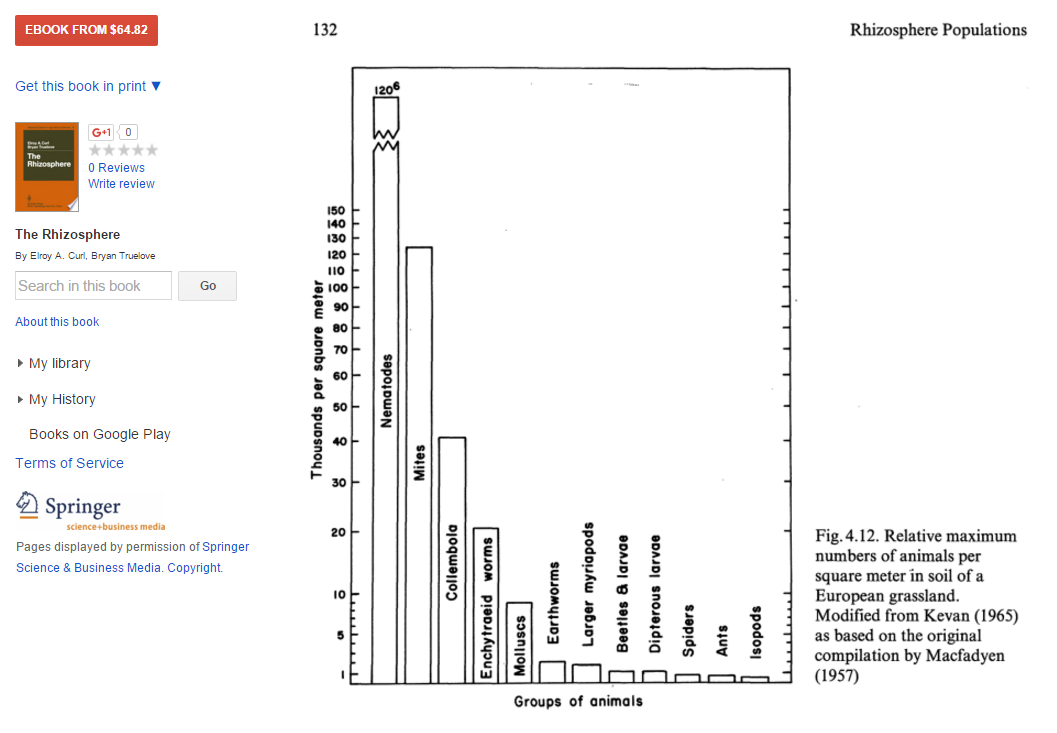
This figure shows earthworms at a few thousand per square meter, slightly but not dramatically higher than in Brady (1974)'s table. Maybe this is because this figure shows "maximum numbers of animals"? This figure also shows that populations of other (non-nematode) fauna are in the range of thousands to hundreds of thousands, consistent with Brady (1974)'s table. I don't know what the "1206" number on top of the nematode bar means. Maybe it's supposed to say "106", but if so, that would imply nematode populations of 106 thousand = 109 per m2, which seems too high based on Brady (1974)'s table. Perhaps it's supposed to be just 106 per m2, which seems about right.
Hillis et al. (2010)
Hillis et al. (2010), p. 474:
Nematodes are probably the most abundant and universally distributed of all major animal groups. [...] Countless nematodes live as scavengers in the upper layers of the soil, on the bottoms of lakes and streams, and in marine sediments. The topsoil of rich farmland may contain 3-9 billion nematodes per acre [0.7 to 2 million per m2]. A single rotting apple may contain as many as 90,000 individuals.
This estimate of densities per m2 agrees with the lower end of Brady (1974)'s table.
Fittkau and Klinge (1973)
Fittkau and Klinge (1973) give (p. 6) the following numbers for "a central Amazonian rain forest near Manaus, Brazil" (p. 2).
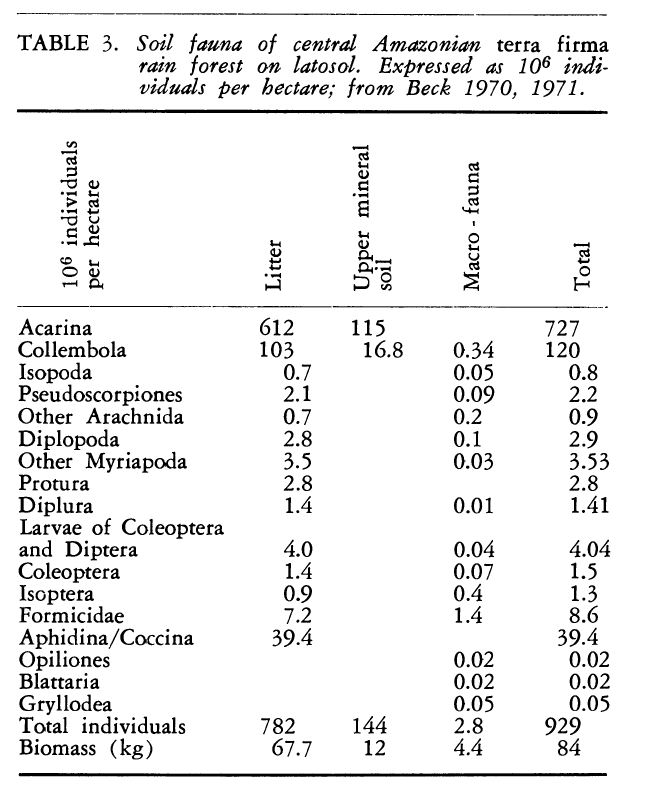
Fittkau and Klinge (1973) also report the following biomass composition (Fig. 2, p. 8), where I've added common names in purple using information from Wikipedia:
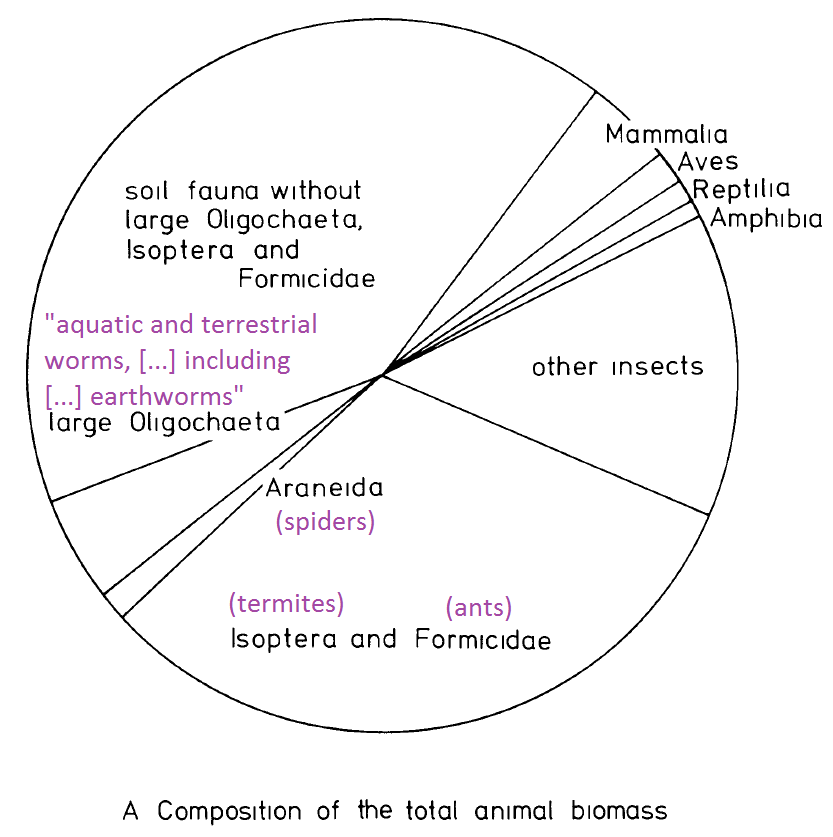
Reagan and Waide (1996)
Reagan and Waide (1996) compiled research done on "a 40 ha area of forest around the El Verde Field Station in the Luquillo Experimental Forest of Puerto Rico" (pp. ix-x). Appendix 14.B (pp. 508-10) reports the following soil-organism numbers. According to p. 510, "Biomass is calculated using dry weight unless otherwise indicated."
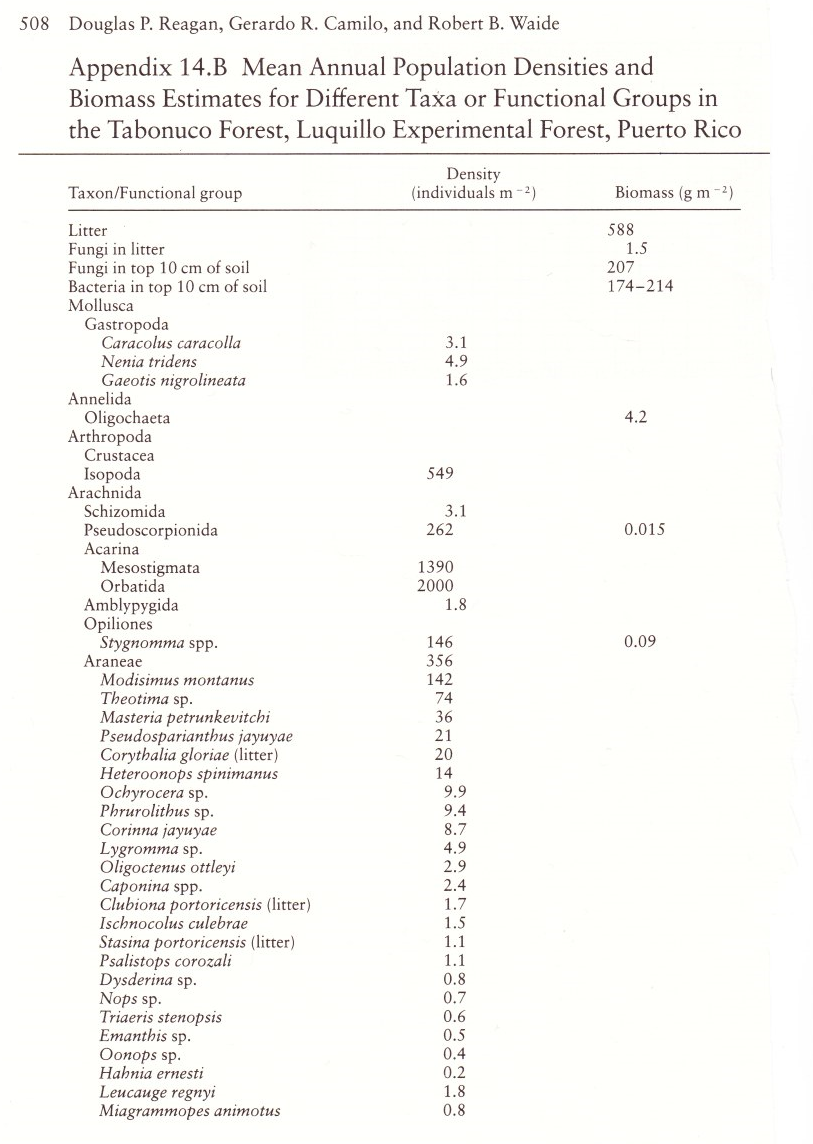
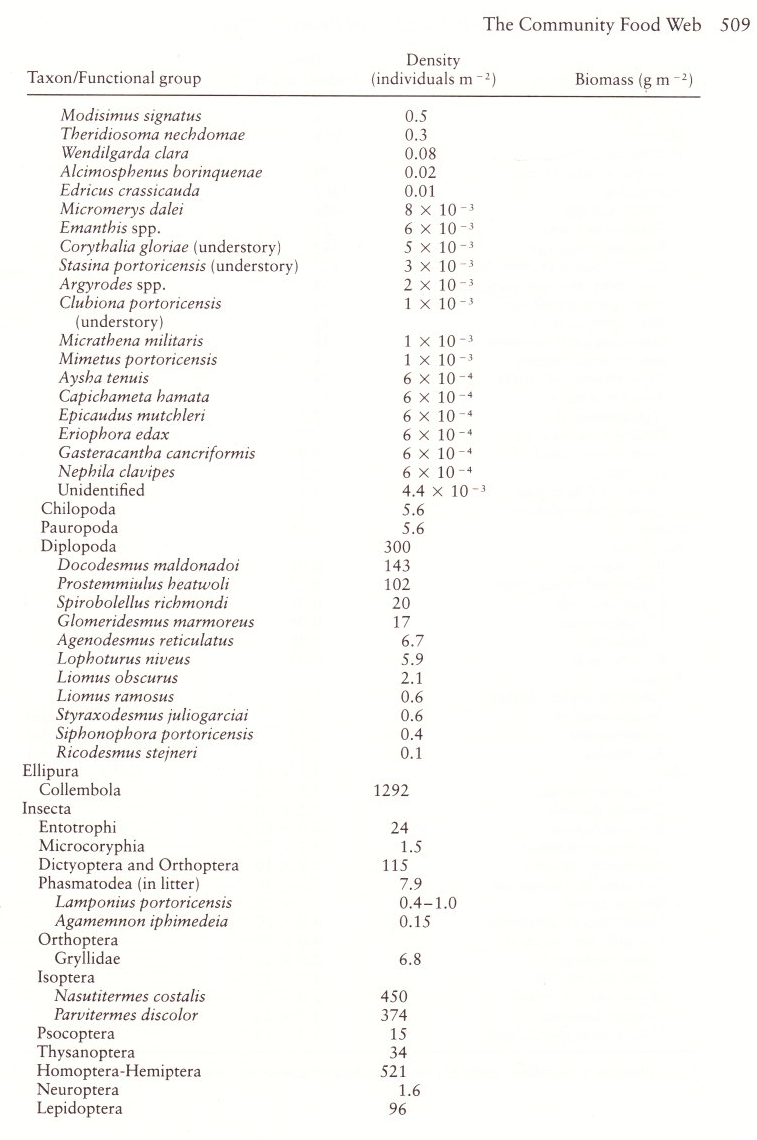
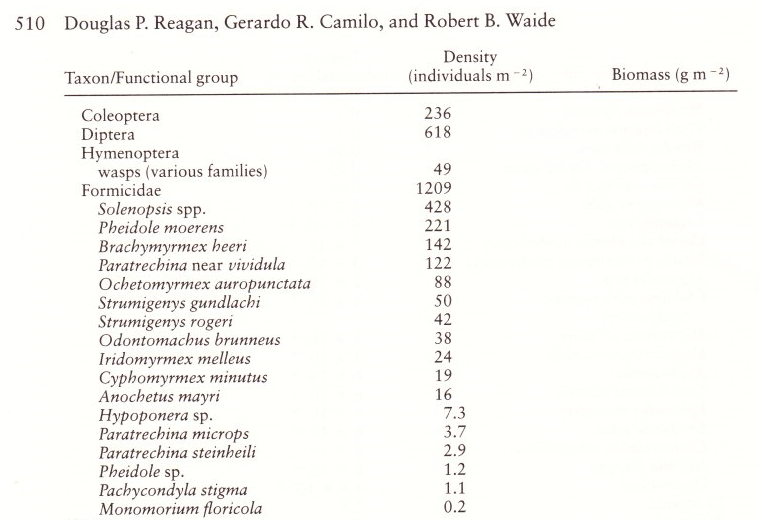
Specific invertebrate abundances
Pearse (1946) says (p. 142):
Kubiena (1938) states that in England nematodes are the most numerous soil animals, and that mites and collembolans come next. [...] Bornebusch (1930) in northern Europe found that mites were the most numerous animals (1,000-10,000 per m2); collembolans came next (500-7,000 per m2). He weighed soil animals and found 76.81 grams per m2 in "superior oak" and 5.25 grams per m2 in impoverished soil. He also observed that there were relatively more predators in poor soils. Starling (1944) found 1,672,704 pauropods per acre in oak stands and 2,178,000 in pine in the Duke Forest. The writer [i.e., Pearse (1946) himself] did not find so great a difference. In any soil the smallest animals are most numerous, yet Eaton (1943a) estimates that there may be 1,000,000 earthworms per acre [i.e., ~250 per m2] in good farm land and further states that if people were as small as soil animals the whole population of Chicago could be contained in 22 square feet.
Sabrosky (1952) says (p. 5):
The normal population of insects, not counting swarms or unusual increases, has been studied for some situations and some species. The best figures we have are for insects living in the soil, probably because it is easier to get practically complete samples of the population. Even so, the data are hard to compare because the studies are so different: Different kinds of soil or time of year, samples taken down to different depths, and treated in different ways that might or might not find such small things as mites and springtails. Because those two kinds far outnumber all other animals in most soils and forest litter, a small difference in technique could make a difference of millions per acre in the number of insects reported.
Studies of grassland insects in England, in which the top 9 to 12 inches of soil was examined, disclosed totals for insects and mites that ranged up to several hundred million per acre.
Even for specific kinds of insects, the estimates may be unbelievably high. For example, certain wireworms, such as the larvae of Agriotes beetles, have been found in numbers calculated to be from 3 million to 25 million per acre. In most of the reports, mites and springtails formed two-thirds or more of the total [...].
In a scrub oak area in Pennsylvania [...], C. H. Hoffmann and his coworkers found an average of 9,759 arthropods per square foot of surface in 2 inches of litter and 1 inch of humus. That figures out to 425 million per acre. [...] the mites were the most abundant kind of animal, averaging 294 million per acre. Springtails averaged 119 million, with only 11 million for all other arthropods. The number per acre is an estimate based on the average of square-foot samples. It may be smaller in some parts of an area and much larger in others.
Smil (2013) says (p. 10):
the total fresh-weight zoomass density of different termite species can add up to more than twice as much (on the order of 100 kg/ha) as the biomass of elephants (Inoue et al. 2001).
Footnotes
- One way to figure this out is to see that the table lists Nematoda as 10 to 100 per gram. If this meant "10 to 100 nematodes per gram of nematode biomass", then the average nematode would have a mass of at least 1/100 g = 10 mg. But in fact, according to some Google results for the search {nematode weight μg}, individual nematodes tend to have masses within one or two orders of magnitude of 1 μg, which is 4 orders of magnitude off from 10 mg.
Another way to see that "Number per gram" means "Number per gram of soil" is the following. If we divide "Number per square meter" by "Number per gram" to calculate g/m2, we get about 105 grams = 100 kg per square meter for each of the rows. This seems to be in the same order of magnitude as the mass of soil in a square meter to a depth of 15 cm. The details of this calculation are in the next paragraph.
The volume of a square meter 15 cm deep is (15 cm)(100 cm)(100 cm) = 1.5 * 105 cm3. This page says: "Determining the weight of soil in an acre furrow slice involves knowing the dry bulk density of the soil in question. Often, a soil bulk density of 1.33 grams/cubic centimeter is used because this approximates the bulk density of a silt loam soil. Keep in mind that bulk densities of soils vary, and are usually higher than 1.33 grams/cubic centimeter for sandy soils and lower for organic soils." This seems to be counting only dry soil, so adding in soil moisture would increase the density somewhat. Let's imagine that the density of wet soil is 2 g/cm3. Then we have (2 g/cm3) * (1.5 * 105 cm3) = 3 * 105 g = 300 kg of soil total. Also, I'm not sure if "Number per gram" means "Number per wet gram" or "Number per dry gram", so maybe I should have used a dry density of soil. (back)